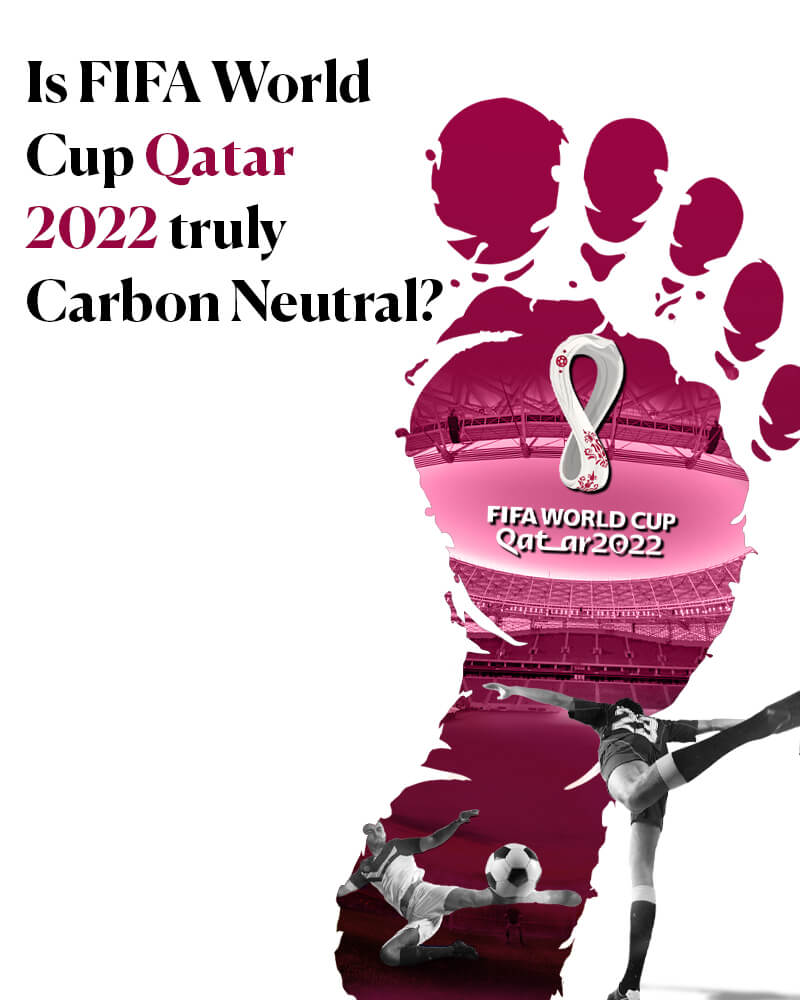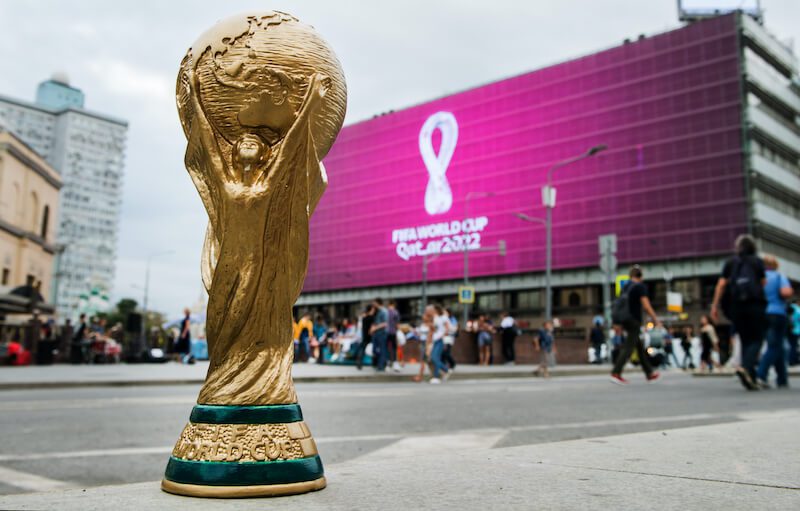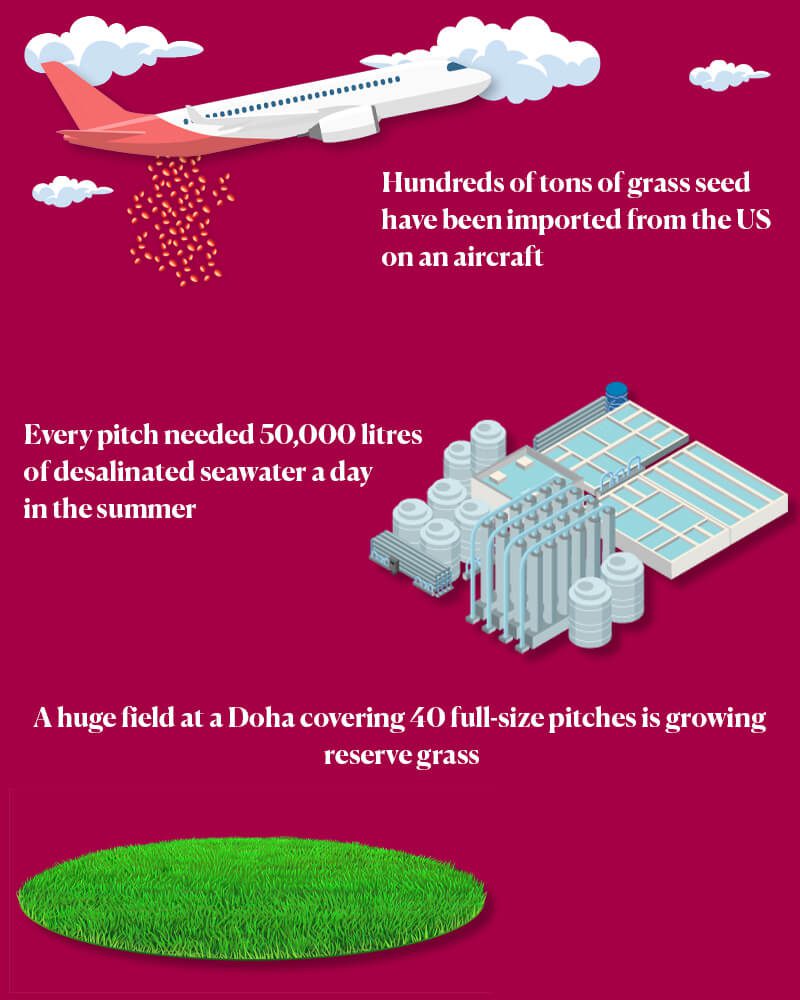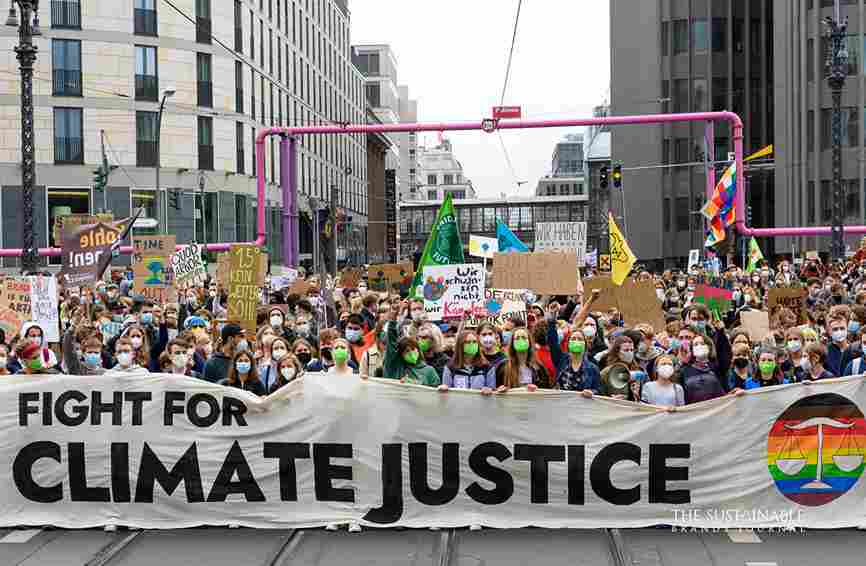
Is FIFA World Cup Qatar 2022 truly Carbon Neutral?
FIFA 2022 is just around the corner and it is set to be the first carbon-neutral World Cup – or so they claim. With much misleading information, human rights violations and dubious carbon offsetting plans, Qatar World Cup’s sustainability declarations have been under fire.
|| Qatar has the highest per capita Carbon Emissions
With 1.5 million fans estimated to visit Qatar for the games and 5 billion viewers expected to tune in to watch the games, it goes without saying that FIFA and Qatar’s carbon-neutral schemes will have a far and wide impact on the people, the economies and the planet.
Many reports have pointed to the gaping holes in the carbon-neutral plans for the tournament and have called out the organizers for greenwashing the event.
But what does it mean to be ‘carbon neutral’ and could the FIFA 2022 World Cup actually be carbon neutral?

What is ‘Carbon Neutral’?
Greenhouse gas emissions (aka Carbon emissions) are generated during each step of planning, organization and execution of any event, especially an event as grandiose as the FIFA tournament.
Being ‘Carbon Neutral’ means that the amount of carbon emissions produced by the event will be compensated by funding projects that would either:
1. Capture and store carbon emissions from the atmosphere (through funding reforestation and carbon capture projects) or
2. Prevent carbon emissions (by investing in renewable energy, for instance)
A successful Carbon Neutral project would:
1. Limit carbon emissions at the planning and execution stage
2. Estimate the emissions that would be produced despite the effort
3. Offset the emissions by purchasing carbon credits from various projects (one credit = 1 tonne of CO2 emission)
But FIFA and the Qatari organizer – the Supreme Committee for Delivery and Legacy (SCDL) – are failing at each of these steps.
Let’s take a look at Qatar World Cup’s environmental impact.
Is the Qatar World Cup carbon neutral?
Many organisations – including Greenpeace, Carbon Market Watch, and New Weather Institute – have come forward to question the integrity of FIFA’s sustainability strategy and Qatar 2022’s Carbon Neutral claims, including:
1. Mega-Construction projects almost exclusively for FIFA 2022
When Qatar was awarded the hosting rights in 2010, it had only one stadium that could host the tournament. Since then, Qatar has built 7 air-conditioned stadiums (6 permanent and 1 temporary), around 100 hotels, new roads, a new metro system and a new airport! These $220 billion worth of mega-projects have left many worrying about the environmental impact of the FIFA world cup.
Construction projects are emission-intensive, to begin with, and also require a lot of water and energy. This is a recipe for disaster for a desert country like Qatar that relies almost entirely on fossil fuels for energy and almost half of its water requirements are fulfilled by desalinating seawater water – a process that requires a lot of energy and is also disruptive to the ecosystem.

|| Each football pitch needed 50,000 litres of desalinated water per day during summer. (Source)
The organizers are defending these exorbitant projects by claiming that all of the new infrastructures will continue to serve their purpose as part of a development strategy. Unfortunately, these plans are hardly convincing because:
1. Qatar hosted limited sporting events. Hence, if the country didn’t require 6 new permanent stadiums with 40,000 to 80,000 people capacity before FIFA, chances are Qatar won’t need the stadiums after the games either, or at least not to their full potential.
2. These concerns aren’t new. During the 2014 World Cup, for instance, many new stadiums were built in Brazil with intention of being used after the tournament ends, but currently, one of the stadiums in Amazon is hardly used, while another is being used as a bus parking lot. A similar scenario is also seen in South Africa which hosted the 2010 games.
|| “They’ve been building infrastructure only for this event, which is never a good thing.”
– Morten Thorsby, Norwegian Footballer
2. The gross underestimation of the emissions
The past FIFA events have had a huge emission footprint as is expected from events of this magnitude. FIFA 2022 is no exception but the additional infrastructure and geographical location are set to increase Qatar World Cup’s carbon footprint way beyond expectations.
According to the GHG Accounting report released by FIFA, the footprint of the tournament is expected to be 3.63 MtCO2e (Megatonnes of carbon dioxide equivalent – a measure of the quantity of GHGs emitted), that’s more than twice the annual emissions of Bhutan!
|| Russia 2018 FIFA World Cup generated 2.1 million tonnes of carbon emissions
And yet, experts have estimated that the emissions for Qatar 2022 are grossly underestimated due to the methodology the organizers chose to follow.
The construction of new infrastructure contributed the most to the emissions but World Cup organizers will take into account only a small fraction of the total emissions from the construction of the permanent stadiums (only 5.5% of the tournament’s total emissions). This is because the 6 permanent stadiums are considered to be “shared assets”. That is, since the stadiums will be used by other parties after the 2022 World Cup, the organizers will only take the responsibility for a percentage of the emissions based on the duration during which the stadiums are used for the tournament.
|| The true emissions for the stadiums could be as much as 8 times higher than estimated by the World Cup organizers, according to Climate Market Watch
Such calculations for shared or leased assets are a common practice but in this scenario, it is unclear whether or not these venues would be used to their full potential after the tournament ends. This argument is also only valid if these infrastructures would have existed irrespective of the 2022 World Cup, which is highly improbable. Thus, it’s only logical for the World Cup organizers to rethink their contribution.
Besides this, the increased frequency of air travel, energy consumption, travel and accommodation would add a significant amount of emissions, these estimates also seem to be underestimated.
|| “Who can honestly believe that the construction of air-conditioned stadiums in the middle of a desert can be carbon neutral?” Jeremie Suissa, executive officer at Notre Affaire A Tous

3. Using dubious Carbon Offsets
Even if we were to agree with FIFA’s emission accounting, carbon offsetting is not a solution and its effectiveness is debatable. The organisers would need to buy at least 3.6 million carbon credits to offset all the Carbon Emissions. So far, the organizers have accounted for only 1.8 million carbon credits.
To add to the greenwashing accusations, the organizers are set to buy offsets from a newly established Qatari carbon offset registry named Global Carbon Council (GCC). Here is why this is suspicious:
1. Carbon Offset Registries are organisations that track, verify, certify, and award offset credits. The well-recognized registries – like Gold Standard and Verra – have stringent norms to ensure a genuine offsetting of carbon emissions. But a newer registry like GCC is laxer in its approach, and hence, it is also cheaper.
2. The projects that the World Cup organizers would be funding through GCC are all renewable energy projects set mostly in Turkey and Serbia. Major registries tend to refuse renewable energy projects as these projects are unsuitable for carbon offsetting.
3. This is already a red flag but to add to the worries, at least a few of these projects had already commenced before GCC was established, hence there is a high chance that these projects would have happened even without FIFA’s “support”.
|| The entire premise of offsetting is to fund carbon-capturing or carbon-reducing projects that would not exist without the funds.
To add fuel to the fire, GCC is an initiative by Gulf Organization for Research and Development (GORD) which is owned by a Qatari real estate development company and receives funds from Qatar’s Sovereign Wealth Fund – which unsurprisingly, is funded almost entirely by Qatar’s fossil fuel industry.
Cheap offsets from the registry with dubious funding hardly invoke confidence in the integrity of the Carbon Neutral plans. To make matters worse, FIFA’s report has made a laughable claim of absorbing “thousands of tonnes of carbon per year” through tree and turf nursery – which is likely to be the largest turf farm in the world.
Even though grass and trees absorb carbon, claiming that it is carbon reduction is ridiculous because carbon capture involves capturing and storing carbon for at least a few centuries, the lawn grass is unlikely to do that. This project is also a grave threat to the local ecosystem as growing large turfs and trees in a desert requires an enormous amount of water and other resources that Qatar simply doesn’t have.
|| Hundreds of tonnes of grass seeds were flown into Qatar from the USA to create perfect football pitches (Source)
Was Qatar the right choice for a FIFA tournament?
No. FIFA’s choice to choose Qatar has been under scrutiny from the get-go. The recent revelations of the blatant disregard towards the environmental impact and human rights further strengthen this view.
All in all, FIFA 2022’s goal of achieving Carbon Neutrality is based on tall claims, suspicious projects and a lot of greenwashing. So far FIFA has released an ex-ante (before the event) estimate of the emissions and plans to release an ex-post report to explain the discrepancies but they strongly deny any lapse in their Carbon Neutrality plan.
To add to Qatar World Cup’s problems, climate activists from several European countries have also filed complaints against these misleading claims. Many football players and groups have also come forward with an open letter, asking FIFA to scrap the ‘Carbon Neutral’ claims and to take responsibility for their impact by trying to reduce the emissions.
In response to various allegations, FIFA sent a letter to the 32 participating teams asking them to “now focus on football” and that football should not be “handing out moral lessons”. Needless to say, this message was not received well.
Riya Dani is an educator and a writer who talks about Climate Change, Degrowth, and the Role of the Economy and Governance in solving the Climate Crisis. She has a special interest in Environmental Justice, Sustainable Business Models and Social enterprises.





